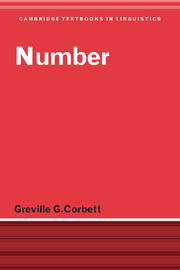Book contents
- Frontmatter
- Contents
- List of figures
- List of tables
- Preface
- List of abbreviations
- 1 Introduction
- 2 Meaning distinctions
- 3 Items involved in the nominal number system
- 4 Integrating number values and the Animacy Hierarchy
- 5 The expression of number
- 6 The syntax of number
- 7 Other uses of number
- 8 Verbal number
- 9 Conclusion and new challenges
- References
- Author index
- Language index
- Subject index
5 - The expression of number
Published online by Cambridge University Press: 05 June 2012
- Frontmatter
- Contents
- List of figures
- List of tables
- Preface
- List of abbreviations
- 1 Introduction
- 2 Meaning distinctions
- 3 Items involved in the nominal number system
- 4 Integrating number values and the Animacy Hierarchy
- 5 The expression of number
- 6 The syntax of number
- 7 Other uses of number
- 8 Verbal number
- 9 Conclusion and new challenges
- References
- Author index
- Language index
- Subject index
Summary
It is now time to look at the ways in which number is expressed. This rather basic issue is a surprisingly novel one. Of course, many grammars describe number marking in individual languages but little has been done towards a typology. We shall therefore give an initial typology, one which aims to list the possibilities (claiming that the listed types can exist and no more). The obvious candidates for number expression are all found: special words (§5.1), syntax (§5.2), morphology (§5.3) and lexical means (§5.4). We shall then examine three types of system which are distinctive and which belong here in a discussion of means because they do not give rise to new semantic distinctions. (This is why they were not treated in chapter 2.) These are inverse systems (§5.5), minimal-augmented systems (§5.6) and ‘constructed’ numbers (§5.7). Finally we take up the discussion of the reduced expression of number, considering the form of items which are not (or not fully) within the number system (§5.8).
The main typological point is the importance of comparing like with like. In previous chapters we examined number values and their ranges of availability and compared each of these across languages. Now we turn to the means of expression, and must continue to be clear about when our claims relate to meaning and when to the means of expression.
- Type
- Chapter
- Information
- Number , pp. 133 - 177Publisher: Cambridge University PressPrint publication year: 2000



